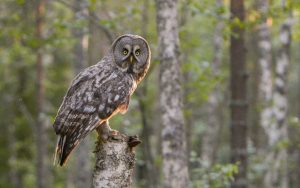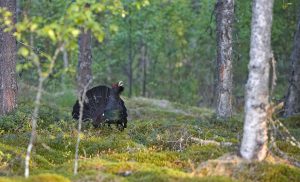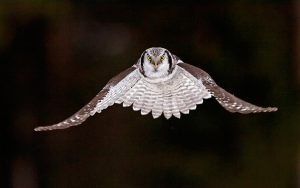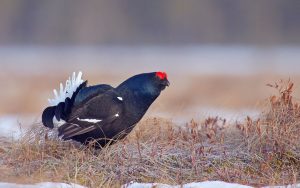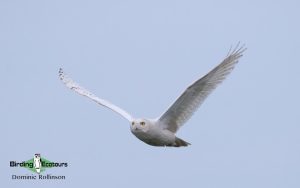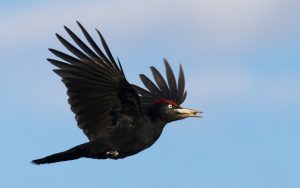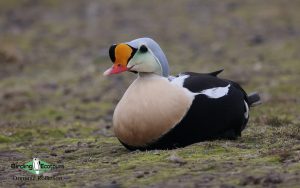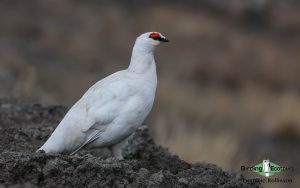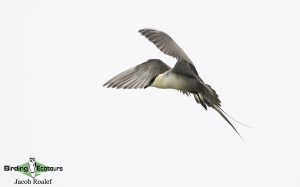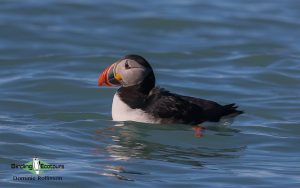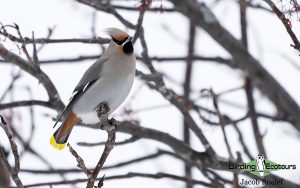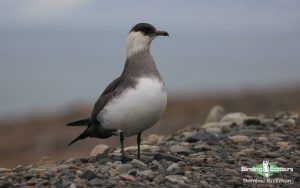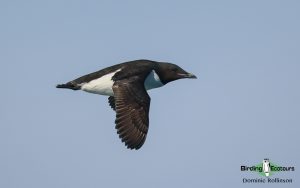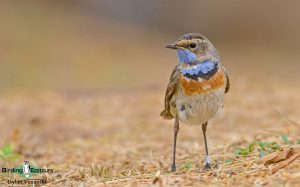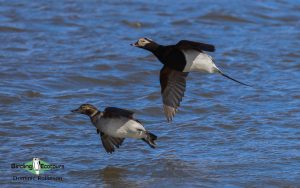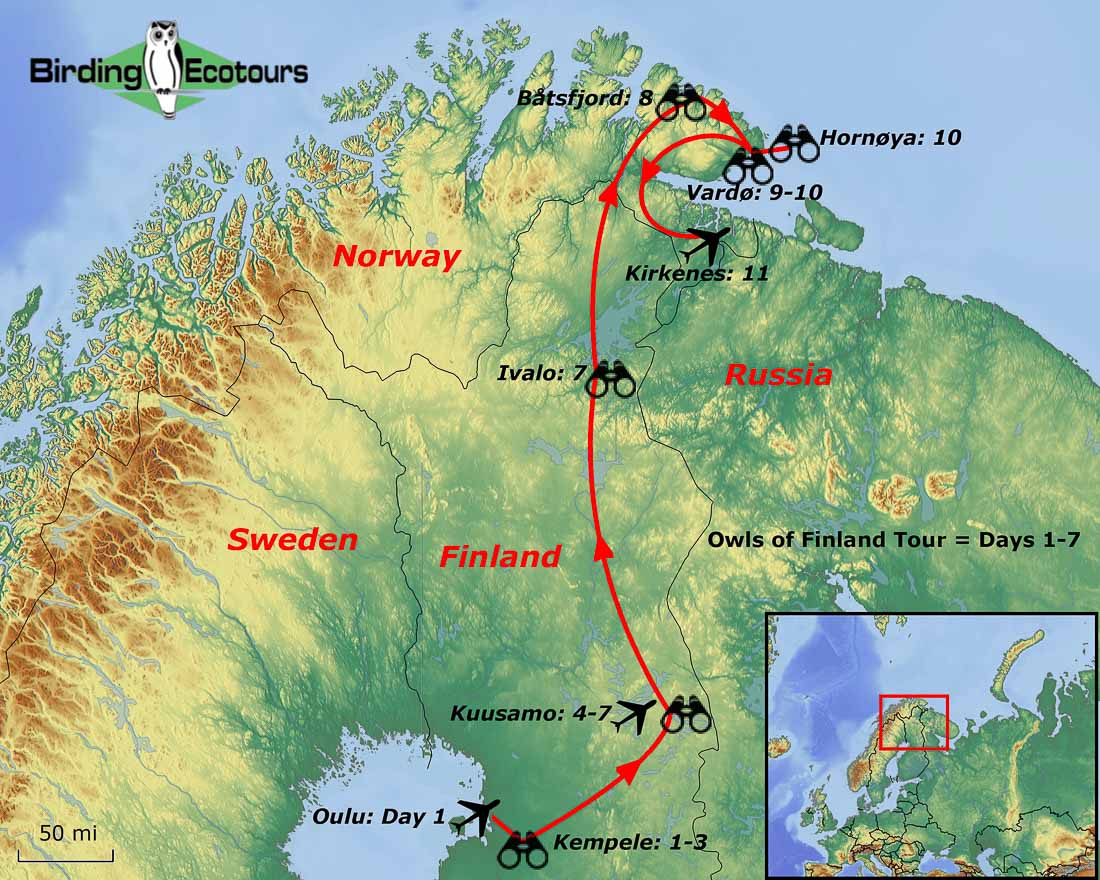Birding Tour Finland and Norway: Taiga and Tundra Adventure
Go to: Finland Birding Tours | Norway Birding Tours | Birding Tours in Europe | All our birding tours
Birding Tour Finland & Norway : Taiga and Tundra Adventure
June 2024/2025/2026
There has been a long-held mysticism among birders regarding the northern part of Finland and Norway. The area conjures up images of vast forests, biting temperatures, and months of darkness. The reality is that the north of both Finland and Norway are two of Europe’s premier birding locations and our Taiga and Tundra Adventure Tour will showcase just that, with the bonus of 24 hours of daylight to maximize our birding experiences. While it is true that there are vast swathes of taiga forest, there are also stunning fjords, miles of breathtaking tundra, rocky mountain peaks, otherworldly coastlines, and charming fishing villages to enjoy. Moreover, there is a simply fantastic selection of wildlife, no more so than the avifauna of the region. This tour will cover the full range of habitats available as we make our way through Lapland’s vast emptiness before joining the breathtaking Varangerfjord and exploring its length in its entirety.
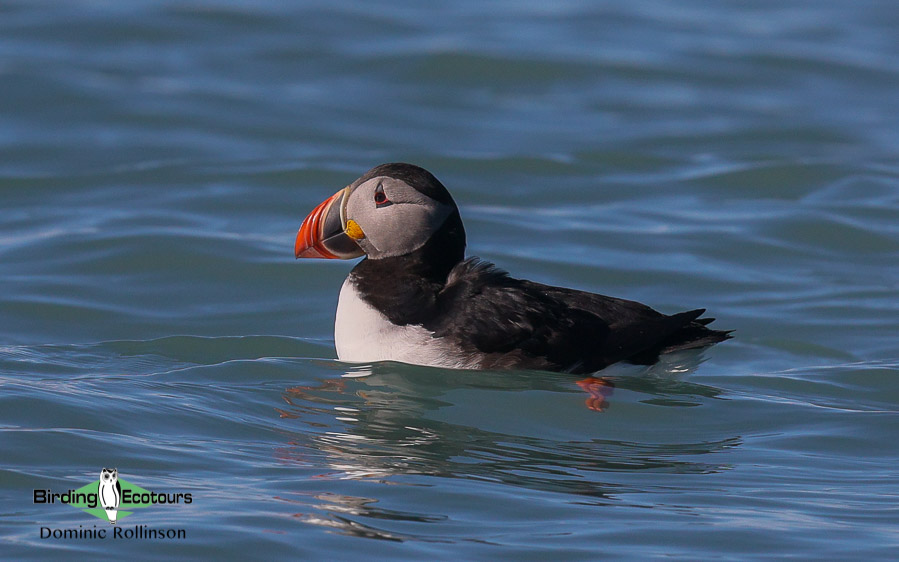
Birding in the northern latitudes presents its own unique set of experiences. June in the region is surprisingly dry, as this area of Finland and Norway is sheltered from the Atlantic currents that bring lots of rain up through Scandinavia. This means that we will generally find good weather which, combined with the midnight sun, will give a lot of birding hours to enjoy. These northern latitudes do not have the sheer number of species you will find further south in Europe, but the climate and environment has led to a fascinating diversity of highly sought-after species that thrive in these areas.
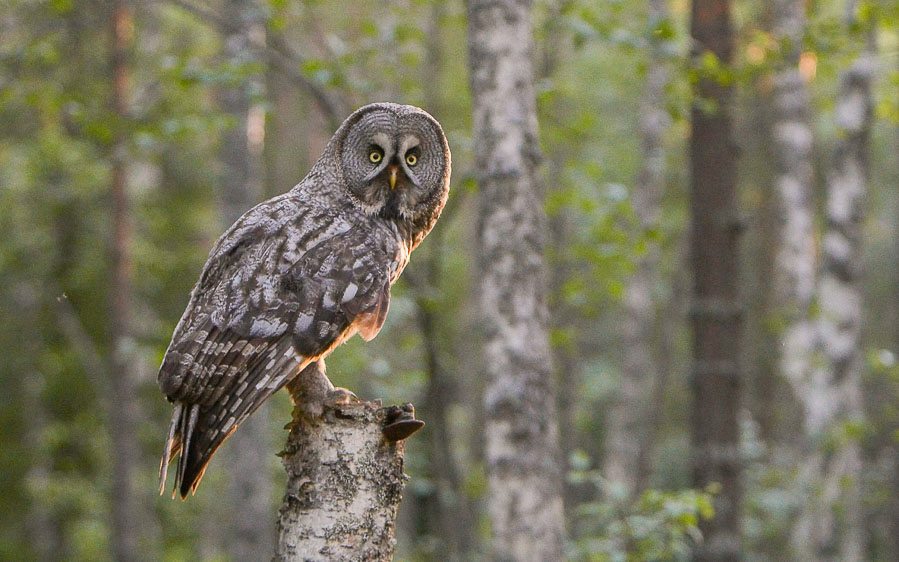
We will begin our tour in the city of Oulu in the northern part of southern Finland. Over the first three days of the tour we will explore the vast forests of the area. These forests are arguably the best in Europe for breeding owls and these will be the focus of the first part of our tour. With the aid of excellent and knowledgeable local guides, we hope to come across a remarkable eight species of owls. Whichever species we see will no doubt be an unforgettable experience, as is always the case with this charismatic family of birds. The forests here are also home to a range of other fascinating species, including Black Grouse, Western Capercaillie, Black Woodpecker, and Eurasian Three-toed Woodpecker, amongst others.
While around Oulu we will explore Liminganlahti. This superb wetland area plays host to many wildfowl and shorebird (wader) species. Highlights of our time here will likely include Spotted Redshank, Caspian Tern, Black-tailed Godwit, Garganey, Whooper Swan, and Common Crane. This activity is an irresistible lure to multiple birds of prey including White-tailed Eagle, Western Marsh Harrier, and Peregrine Falcon. Rarer species that we have a chance of coming across here include shorebirds (waders) like Broad-billed Sandpiper and the delicate Pallid Harrier, one of Europe’s rarest (and most attractive) breeding birds of prey. We will also be perfectly timed to witness the fascinating Ruff lek that occurs in the area every summer.
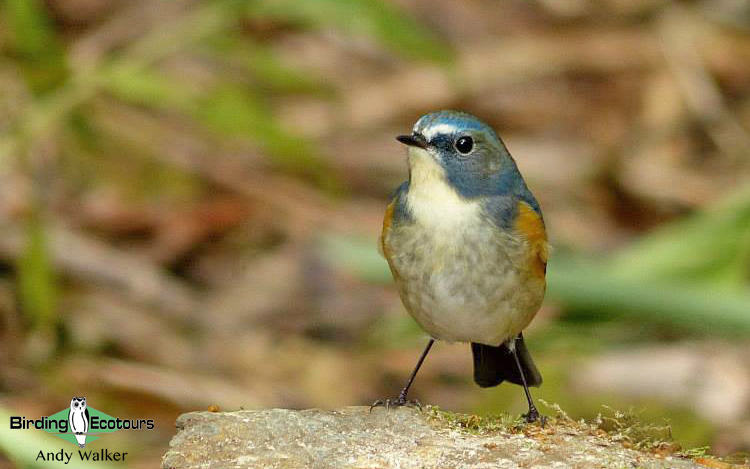
We will then head east across the breadth of Finland to the city of Kuusamo on the Russian border. Along the route we will explore the vast swathes of lakes that form Finland’s interior. Here we will come across Smew, Common Crane, Osprey, Common Scoter, and Eurasian Whimbrel, among others. The variety of birds here is extensive, and as we continue to explore, we will come across small groups of Common Goldeneye, singing Wood Sandpiper, and stunning Brambling. This area of Finland is home to several eastern species of birds including Red-flanked Bluetail, Rustic Bunting, Little Bunting, and Arctic Warbler. Taiga forest specials occur here too, including Grey-headed Chickadee (Siberian Tit), Siberian Jay, Two-barred Crossbill, and Pine Grosbeak. There are simply too many species to list in this introduction to do the area justice, so please see the detailed itinerary below for a more extensive list of the amazing species which occur here.
From Kuusamo we head north on a drive through the beautiful taiga forest to Ivalo before crossing into the Arctic Circle and into Norway. The landscape changes into boggy fells as the Arctic tundra begins to reveal some of its stunning birdlife, such as Lapland Longspur (Lapland Bunting), Black-throated Loon (Diver), Bluethroat, Rough-legged Buzzard, European Golden Plover, and Bar-tailed Godwit. The Tana River itself should hold numbers of Common Merganser (Goosander), plus breeding Temminck’s Stint, and an Arctic Tern colony. The rocky crags bordering the river valley are also a traditional breeding site of the fearsome Gyrfalcon.
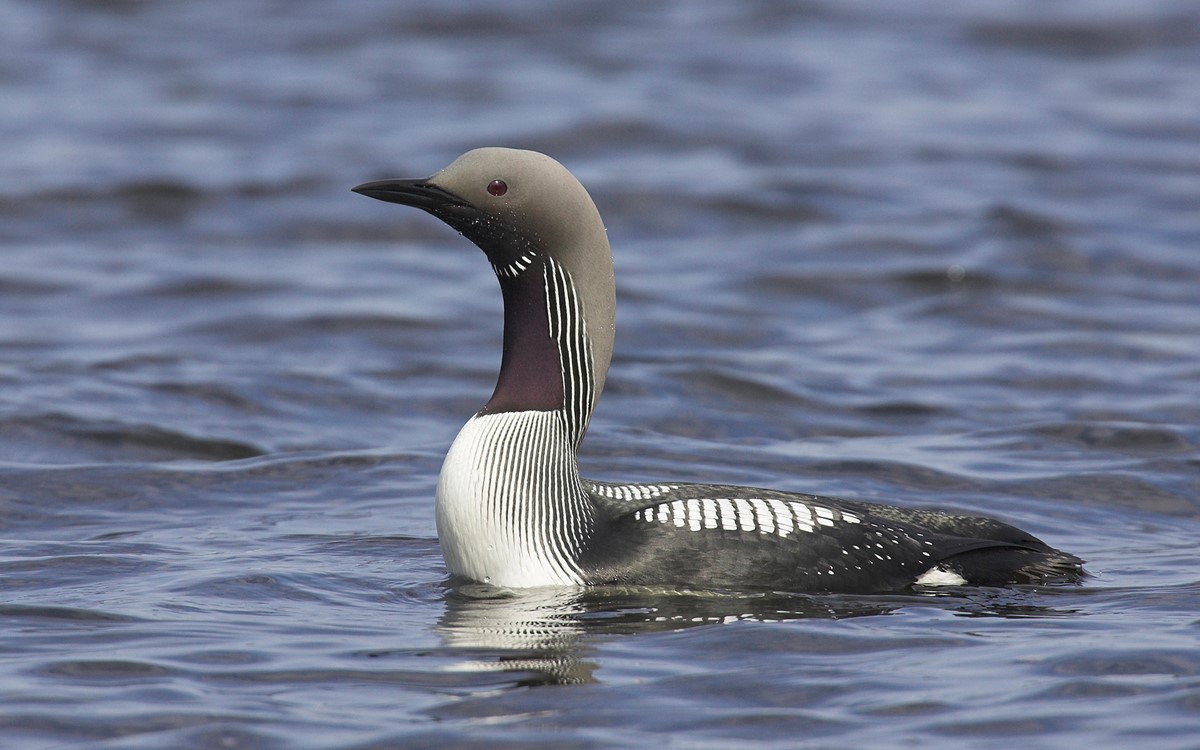
After exploring the river, we head up to the northern harbor town of Båtsfjord on the north coast of Varanger. The high tundra en route is home to specials such as Rock Ptarmigan, Gyrfalcon, Long-tailed Jaeger (Skua), Eurasian Dotterel and, on occasion, Snowy Owl can be seen here too! We will also visit Berlevåg on the coast which is well known as a superb sea-watching site. Braving the Arctic winds here can turn up Yellow-billed Loon (White-billed Diver), Pomarine Jaeger (Skua), Glaucous Gull, Iceland Gull, and Black-legged Kittiwake.
The final leg of our tour is on the stunning Varangerfjord itself. Along the route we will scan the tundra pools for shorebirds (waders) like Eurasian Whimbrel, Red-necked Phalarope, Temminck’s Stint, Little Stint, Ruff, and Bar-tailed Godwit. These lakes and pools are also home to breeding Red-throated and Black-throated Loons (Divers). Further into the fjord we will explore coastal sites for some special wildfowl. With luck, the rafts of Common Eider will be dotted with smaller numbers of the striking and “must see” King Eider and Steller’s Eider (two amazing sea ducks). The tundra areas here will also hold Rough-legged Buzzard, Long-tailed Jaeger (Skua), Parasitic Jaeger (Arctic Skua), Snowy Owl, Short-eared Owl, Bluethroat, Arctic Redpoll, Horned (Shore) Lark, Lapland Longspur (Lapland Bunting), and Snow Bunting.
We will explore the peninsula’s superb seabird colonies. The remote island of Hornøya, off the coast of Vardø, is something to behold. The rocky island is home to 25,000 pairs of Black-legged Kittiwake, plus around 150 pairs of European Shag. The island is also covered in alcids such as Thick-billed Murre (Brünnich’s Guillemot), Common Murre (Guillemot), Black Guillemot, Razorbill, and Atlantic Puffin. This activity attracts the two principal birds of prey here, Gyrfalcon and the massive White-tailed Eagle. Our last destination on the peninsula is the otherworldly Hamningberg. This is quite literally the very end of Europe and a sensational end to our time on the Varangerfjord.
From here we will make the journey back to Ivalo, stopping for birding en route, before drawing our tour to a close. This journey will see us head further east than Istanbul in Turkey and so far north that we cross into the Arctic Circle. This is one tour you do not want to miss!
Itinerary (11 days/10 nights)
Days 1 – 3. Arrival in Oulu, birding the Liminganlahti wetlands and the Oulu region
Welcome to the land of the midnight sun. You will be met at Oulu airport by your Birding Ecotours tour leader and expert Finnish local guide. Our first evening in Oulu will be spent getting settled into our hotel and enjoying a traditional Finnish meal. Here we will discuss the trip and use the time to assist with anything the group may need.
We will spend the first three days of our tour in the area surrounding the city of Oulu. This city of around 200,000 inhabitants is the largest in northern Finland and will be our base for the next few days. Oulu happens to be surrounded by some of the best birding Finland has to offer and we will use the long hours of daylight to maximize the birding experiences here.
Firstly, we will explore the dense taiga forests in search of some of the amazing species that inhabit this vast wilderness. The Oulu region is one of the best in Europe for breeding owls and we will attempt to see no fewer than eight species here. With Snowy Owl being possible on the Norwegian leg of our tour, we could see almost all of Europe’s owl species!
The smallest of these species is the Eurasian Pygmy Owl. Despite its small size this species is a voracious, mainly diurnal hunter, and often hangs around bird feeders and hunts in a fashion like that of small hawks. Another small owl species here is the Boreal (Tengmalm’s) Owl. This species can be incredibly elusive, and our best bet will be to observe this species near nest sites. The next species on the owl size-scale is Northern Hawk-Owl. This striking species is a real star of the taiga forest and it is often seen on roadside wires scanning the grasses for small mammals. It is one of the few owls to be solely diurnal and this will help us locate this species. Within the same habitat as the hawk-owl, we should also come across both Long-eared Owl and Short-eared Owl. All three of these birds prefer slightly more open forested areas with nearby grassland to hunt.
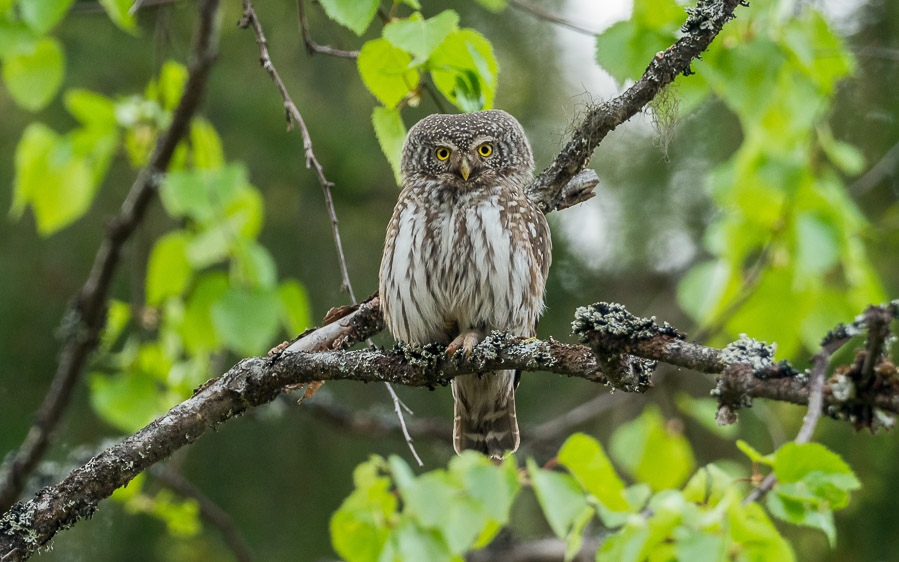
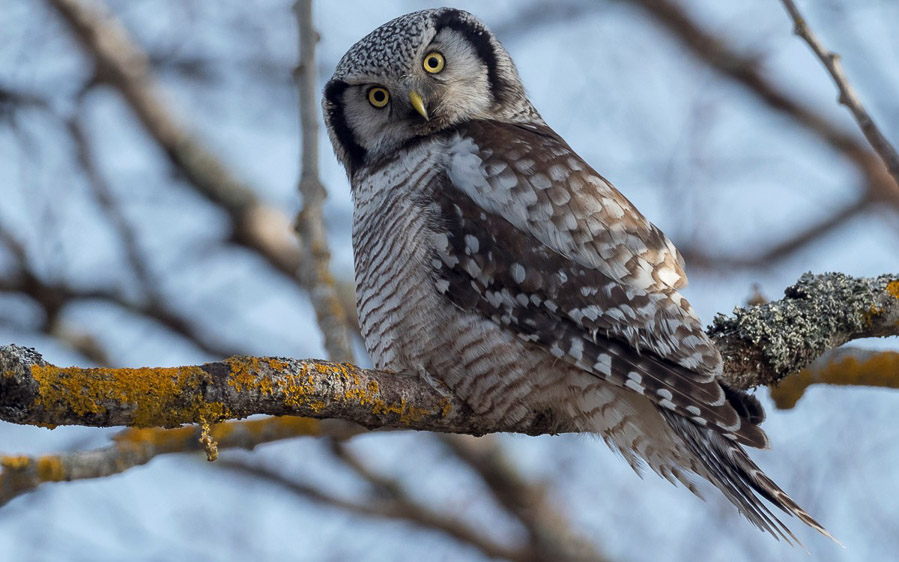
Finally, we move onto the giant owls of the area. Ural Owl, Great Grey Owl, and Eurasian Eagle-Owl dwarf the other owl species here, but this does not necessarily make them any easier to see, though with our excellent local team we will stand a great chance! We will spend plenty of time searching the forests for these three stunning species as well as the other five owl species. While the owl species are the real highlight of the forests, they are not the only amazing species to be found here. The taiga forests in June come alive as the daylight hours increase. By exploring the forest trails here, we should come across forest specials such as Black Grouse, Western Capercaillie, Hazel Grouse, Black Woodpecker, Eurasian Three-toed Woodpecker, Lesser Spotted Woodpecker, Rough-legged Buzzard, and Eurasian Goshawk.
Passerines of the forest can be numerous in June, and we will search for Bohemian Waxwing, European Crested Tit, Great Grey Shrike, Common Rosefinch, Fieldfare, Tree Pipit, Brambling, Hawfinch, Red (Common) Crossbill, Eurasian Siskin, and Yellowhammer. Forest birding can be challenging but this makes the rewards even greater and the forests around Oulo offer some sensational species for us to enjoy.
The second area we will explore during the first three days of the tour is the wetlands of Liminganlahti situated to the south of Oulu. This wetland site is home to a multitude of wildfowl and shorebirds, including Eurasian Curlew, Common Greenshank, Spotted Redshank, Ruff, Little Ringed Plover, Caspian Tern, Black-tailed Godwit, Northern Shoveler, Red-breasted Merganser, and Garganey. Additionally, hundreds of young (non-breeding) Whooper Swans and Common Cranes spend their summer in the bay area. Usual sightings here also include White-tailed Eagle and Western Marsh Harrier, while Peregrine Falcon is a daily visitor from the nearby bog. Broad-billed Sandpiper should have arrived here from May, as well as small numbers of Eurasian Dotterel. Terek Sandpiper, Pallid Harrier, and Citrine Wagtail are much sought-after rare breeding birds in the area.
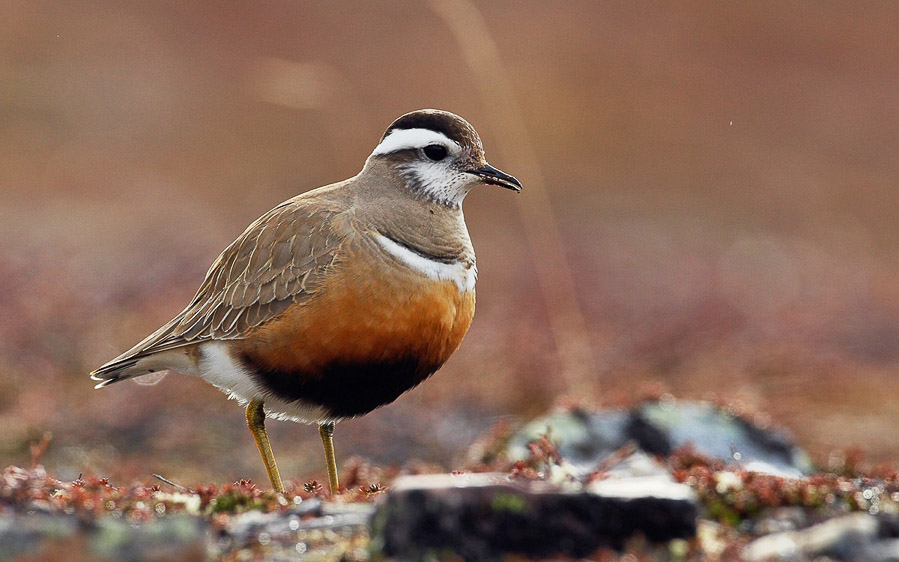
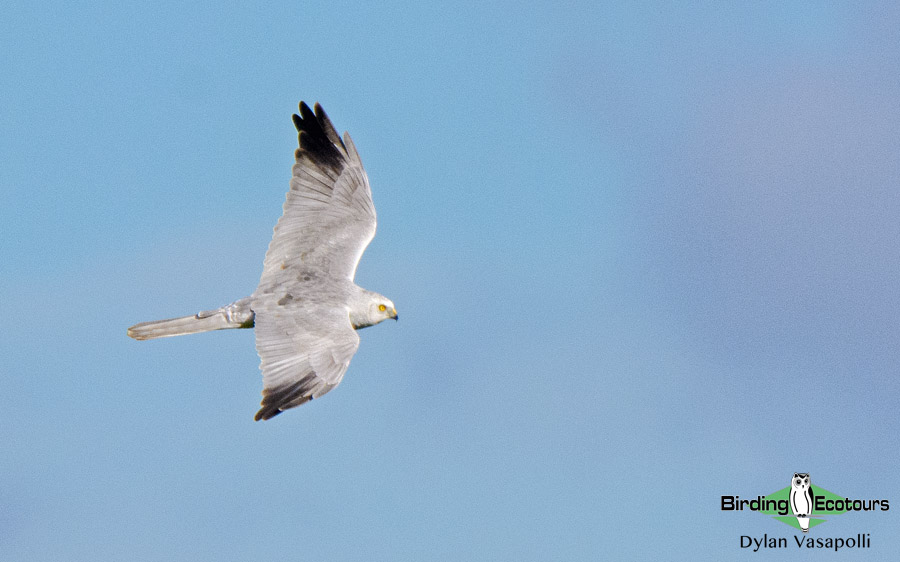
Other shorebirds at the site might include Temminck’s Stint, with its butterfly display flight, as well as Common Ringed Plover and Little Ringed Plover. Liminganlahti also has a spectacular Ruff lek. Differently colored males concentrate on winning the females’ attention in a dazzling display of color and movement, something not to be missed.
During late evening excursions there might be a chance to find Thrush Nightingale and Blyth’s Reed Warbler – and perhaps even Corn Crake, River Warbler, and Marsh Warbler. It is fair to say that all these species have incredible songs and will provide more tour highlights.
Overnight (three nights): Finlandia Hotel Airport Oulu, Kempele, Finland
Days 4 – 6. Birding the Kuusamo region
After three action-packed days around Oulu we will spend Day 4 undertaking our journey towards the beautiful northern regions of Finland. En route we will travel through stunning landscapes blanketed with forests, bogs, lakes, and rivers, with our end destination being the city of Kuusamo on the border with Russia.
Along the way we will stop at convenient points to do some birding around the wet bogs and lakes. In these areas we should come across Smew (one of the best-looking ducks on the planet), Common Crane, Osprey, Common Scoter, Eurasian Whimbrel, Green Sandpiper, Common Goldeneye, Little Gull, and Wood Sandpiper, among others.
As we approach Kuusamo these lakes and bogs are broken up by sections of taiga forest. These are a real draw for species such as Willow Tit, Common Cuckoo, Hooded Crow, Great Spotted Woodpecker, Brambling, Bohemian Waxwing, and Eurasian Siskin.
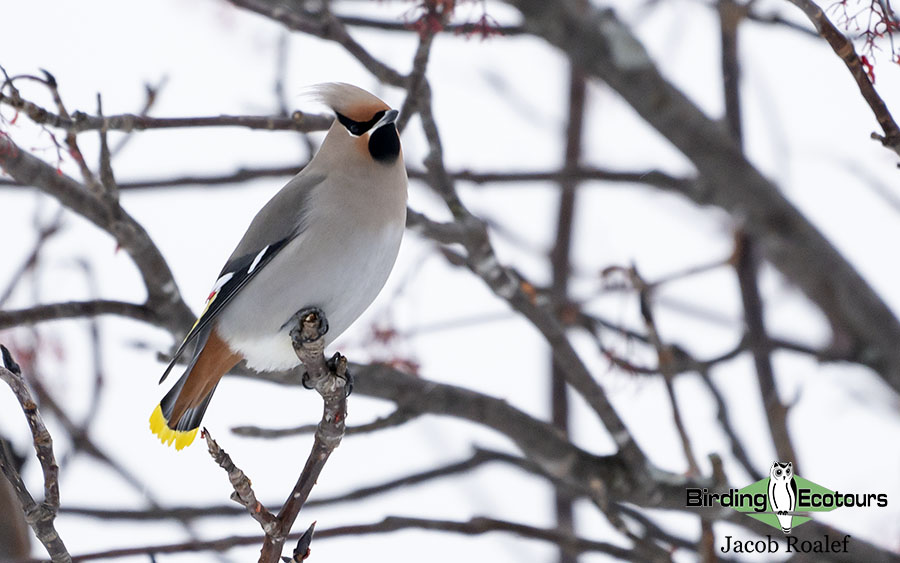
Once in Kuusamo we will explore the superb habitats of the region around the city. The real draw of this region is the presence of several species which are very range-restricted in Europe. While searching for the commoner species mentioned above, we will keep our eyes peeled for Red-flanked Bluetail, Rustic Bunting, Little Bunting, Arctic Warbler, and Grey-headed Chickadee (Siberian Tit). These are all beautiful species and a huge bonus of birding in the area.
We should also be able to add to the above with some real forest specials such as Siberian Jay, Two-barred Crossbill, Pine Grosbeak, and Black Woodpecker. The grassland sections between the forests should hold Rough-legged Buzzard, Great Grey Shrike, and Common Rosefinch.
The habitats closer to Kuusamo will provide us with a different range of species to those found nearer Oulu such as Red-necked Grebe, Spotted Redshank, Broad-billed Sandpiper, and Jack Snipe. Exploring the surrounding forests will give us another chance of spotting Northern Hawk-Owl and Boreal (Tengmalmn’s) Owl, plus Western Capercaillie, Black Grouse, and Willow Ptarmigan.
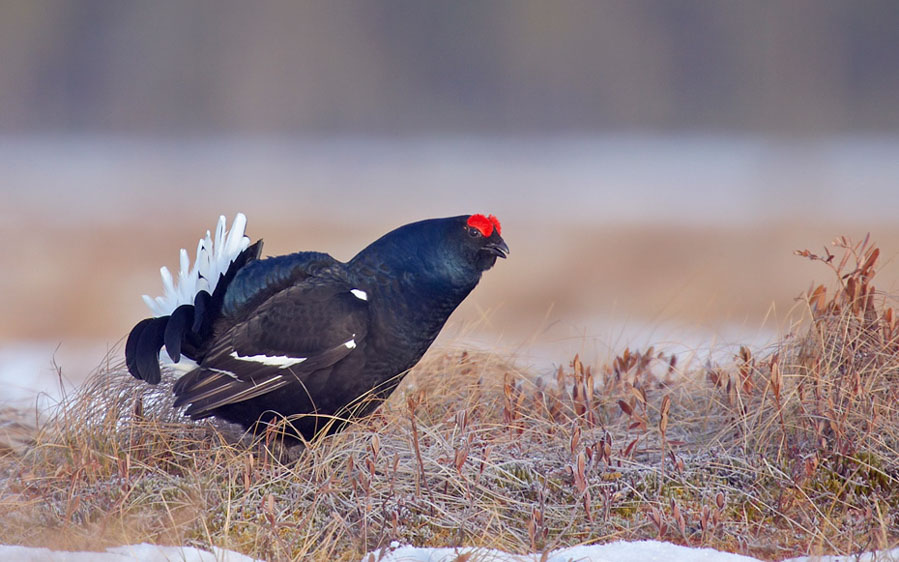
We will also spend time in the breathtaking old forest of the Oulanka National Park. Oulanka is the westernmost extreme of the taiga or boreal coniferous forest zone. In addition to the vast spruce forests, here we can enjoy lichenous upland pine forests, wild river valleys, and watery aapa mires, the flora and fauna of Oulanka’s river valley is a distinctive mix of northern, eastern, and southern species.
One of the true stars of Oulanka is the Red-flanked Bluetail. We will walk up Valtavaara Hill where the birds should be singing and while not guaranteed, the views from the top are worth the climb. While exploring Oulanka we will attempt to see the often-elusive Hazel Grouse and Siberian Jay, and other forest highlights here include Golden Eagle, White-throated Dipper, Red-necked Grebe, Little Gull, European Pied Flycatcher, and Common Redstart.
We will also use the 24 hours of daylight to undertake a night-time forest safari for the four species of Phasianidae found here: Hazel Grouse, Western Capercaillie, Black Grouse, and Willow Ptarmigan. If luck is on our side, we may also have an unforgettable encounter with (European) Brown Bear or Moose (confusingly called Elk in Europe!).
Overnight (three nights): Holiday Club Kuusamon, Tropiikki, Finland
Day 7. Crossing the Arctic Circle to Lapland, transfer to Ivalo
Today will be a travel day as we make the drive north from Kuusamo to Lapland, and the town of Ivalo. We will stop along the route, as we have done in previous days, to look for the area’s key species.
Overnight: Hotel Ivalo, Ivalo, Finland
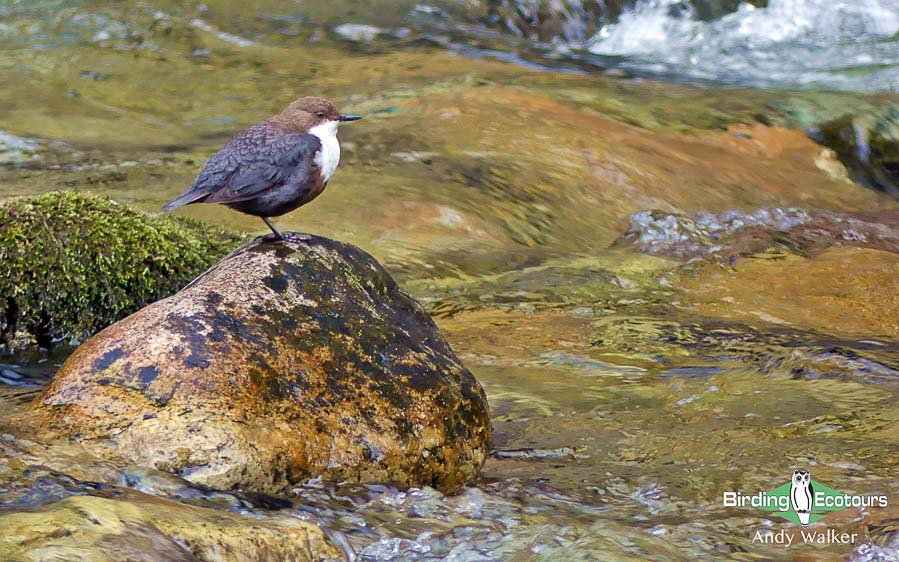
Day 8. Birding the Tana River, its delta in Norway and crossing the tundra to Båtsfjord
Today we will make another northward journey from Ivalo all the way to the northern edge of Europe on the Barents Sea. Along the way we will notice how the landscape begins to change with the vegetation becoming sparser as we move into tundra habitats.
We start by exploring some superb pine forest and bog habitat. Here we will look for similar species to the previous days, such as Siberian Jay, Pine Grosbeak, and displaying Jack Snipe. As we move north, new species will start to reveal themselves. Our first Lapland Longspur (Bunting) should begin to appear along with species like Whooper Swan, Velvet Scoter, and Arctic Redpoll.
As we approach the border with Norway the vast forests begin to give way to more expansive bogs. Here we should come across Black-throated Loon (Diver), Common Crane, Tufted Duck, Common Scoter, Bluethroat, Rough-legged Buzzard, European Golden Plover, Bar-tailed Godwit, and Spotted Redshank.
Next we will drive along the Tana River and into Norway. The ancient deciduous woodland around the river is an excellent spot to look for Northern Hawk-Owl and woodland passerines. We will then visit the Tana River delta, which is famous for its Common Merganser (Goosander), Temminck’s Stint, and other breeding waders, plus its colony of Arctic Tern.
The area is also good for birds of prey with Golden Eagle, Rough-legged Buzzard, Common Kestrel, Peregrine Falcon, and White-tailed Eagle all regular in the area. Furthermore, there is a traditional breeding site of Gyrfalcon on the nearby rocks and we will scan the rock face to try and locate them.
The delta is also a good place to look for Harbor Seal, with the vast river deposits forming islands for them to rest on. These islands also make good loafing sites for birds such as Common Gull, European Herring Gull, Great Black-backed Gull, Lesser Black-backed Gull, Great Cormorant, Hooded Crow, Northern Raven, Common Eider, Whooper Swan, Common Shelduck, and Barnacle Goose. Offshore we may spot passing Parasitic Jaeger (Arctic Skua), Pomarine Jaeger (Skua), and Long-tailed Jaeger (Skua).
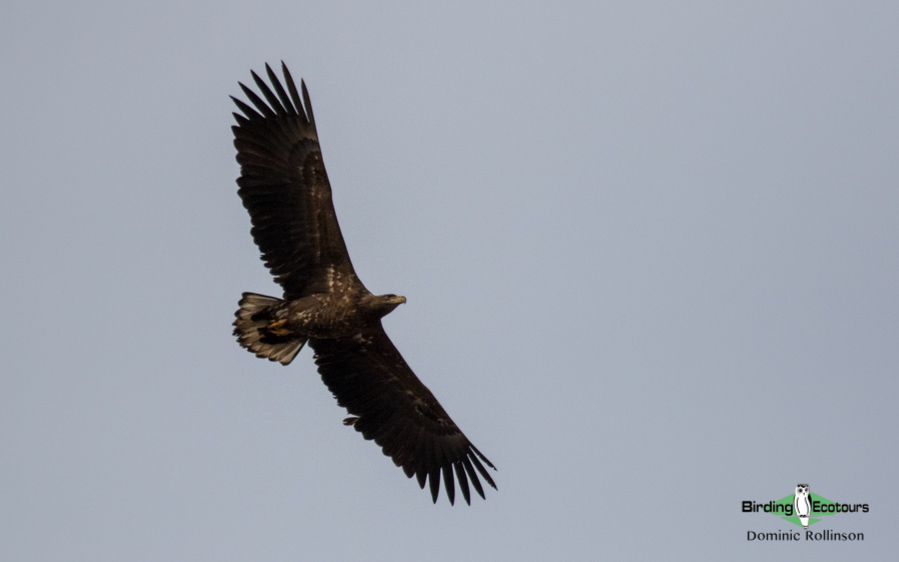
From the Tana delta we once again head north and it is from this point that we will see the most dramatic change in habitat as we enter the true tundra region. As the road twists, turns and slowly begins to climb we will notice that the last of the trees will vanish and in front of us will emerge a vast area of high-altitude tundra, the vast rocky landscape broken up by small bogs and lakes.
We will stop and explore the tundra area and experience the hardy birds that live here such as Rock Ptarmigan, Willow Ptarmigan, Gyrfalcon, Merlin, Long-tailed Jaeger (Skua), Eurasian Whimbrel, Eurasian Dotterel, Lapland Longspur (Bunting), Temminck’s Stint, Red-necked Phalarope, Eurasian Golden Plover, Bar-tailed Godwit, and Long-tailed Duck. We may also come across the stunning Horned (Shore) Lark which spends the summer here and, with luck, the beautiful Snowy Owl.
We then begin to descend off the high tundra towards the most northerly point of our tour, the town of Berlevåg. This town sits right on the coast of the Barents Sea and the location is both beautiful and harsh, in equal measure.
We will make a visit to the Kjølnes lighthouse which provides us with an excellent sea-watching spot. On a good day, the list of birds moving past can be extraordinary. Highlight species of a sea-watch here include Yellow-billed Loon (White-billed Diver), Pomarine Jaeger (Skua), Great Skua, Parasitic Jaeger (Arctic Skua), Long-tailed Jaeger (Skua), Glaucous Gull, Iceland Gull, Black-legged Kittiwake, and Northern Gannet. With the right winds we may also see European Shag, Common Eider, Common Scoter, Common Merganser (Goosander), Common Murre (Guillemot), Razorbill, Black Guillemot, Atlantic Puffin, Common Gull, European Herring Gull, Great Black-backed Gull, and Arctic Tern.
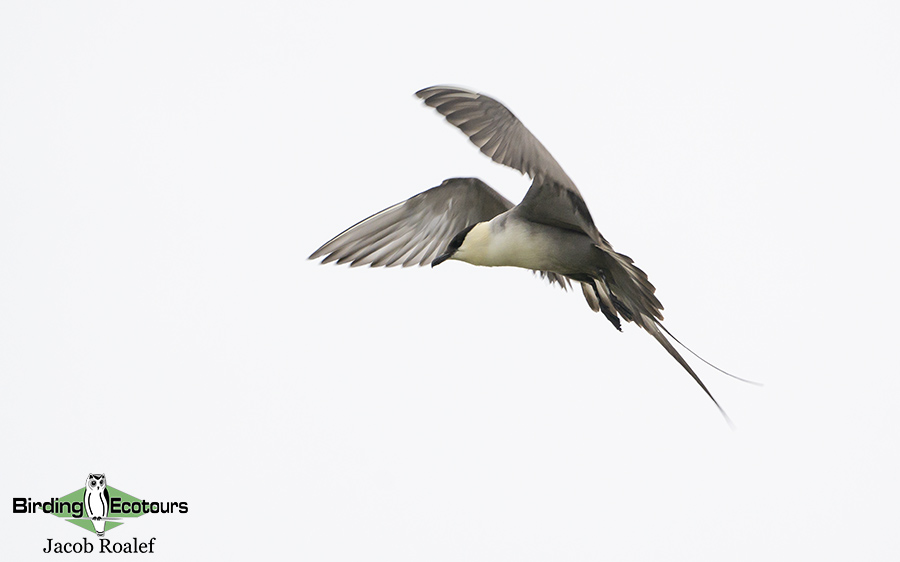
The rocky shoreline here can be a good place to look for shorebirds. Purple Sandpiper is one such species and is the only shorebird which spends the whole year in the area. Other species here at this time of year include Eurasian Oystercatcher, Common Ringed Plover, Eurasian Whimbrel, Wood Sandpiper, Red-necked Phalarope, and many others.
Depending on the snow levels we may be able to venture into the barren tundra behind the town in search of Eurasian Dotterel, Long-tailed Jaeger (Skua), Lapland Longspur (Bunting), and Eurasian Whimbrel. We may also come across migrant passerines around the town, such as White Wagtail, European Rock Pipit, Bluethroat, Northern Wheatear, Barn Swallow, Willow Warbler, and Red-throated Pipit.
We will then return to Båtsfjord where we will spend the night.
Overnight: Båtsfjord Hotel, Båtsfjord, Norway
Days 9-10. The Varangerfjord and Hornøya
The next two days will be spent on the Varangerfjord. Our birding here will be a mixture of tundra walks, checking coastal bays and river inlets, sea-watching, and visiting the huge seabird colonies in the area. We will also search for the key mammals of the area, with the open tundra habitat home to Reindeer, Red Fox, Mountain Hare, and Arctic Fox (although this is a now a very rare mammal here).
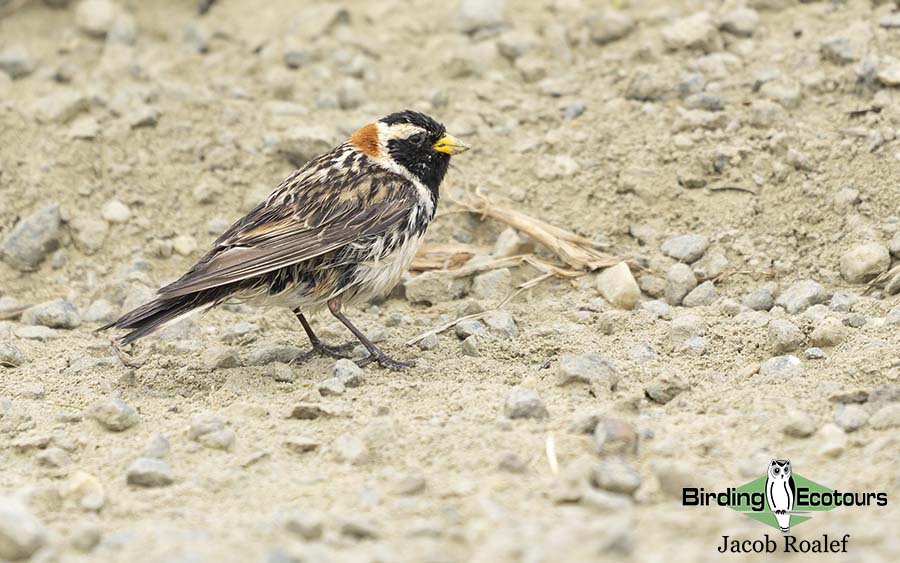
The tundra exploration will be like that of the previous days, however being further south we should come across a bit more variety here as we move back to areas with a bit more tree cover. In these areas we should come across Rough-legged Buzzard, Bluethroat, Short-eared Owl, Arctic Redpoll, Common Redpoll, Horned (Shore) Lark, Snow Bunting, Lapland Longspur (Bunting), Twite, Willow Warbler, Fieldfare, Redwing, Brambling, European Rock Pipit, and plenty of other species. We may also, once again, bump into Northern Hawk-Owl around the villages which lie adjacent to the fjord.
The high tundra off the Varangerfjord will see us come across the breeding territories of Long-tailed Jaeger (Skua), Parasitic Jaeger (Arctic Skua), Red-throated Loon (Diver), Black-throated Loon (Diver), Common Goldeneye, Whooper Swan, Long-tailed Duck, and Red-necked Phalarope. Shorebirds (waders) breed in this area too with European Golden Plover, Eurasian Whimbrel, Wood Sandpiper, Ruff, and Common Redshank all in the higher areas.
Exploring the sheltered bays, river inlets, and harbors along the coast of the fjord will give us fantastic close-up views of several species of shorebirds, ducks, geese, seabirds, gulls, and terns. Some of the key species that we may come across include Purple Sandpiper, Red-necked Phalarope, Temminck’s Stint, Little Stint, Bar-tailed Godwit, Tundra Bean Goose, Northern Fulmar, Pink-footed Goose, Barnacle Goose, Velvet Scoter, Arctic Tern, Glaucous Gull, and Iceland Gull. The real stars of these coastal sites are the rafts of Common Eider which are present here through most of the summer. While common, their stardom comes from often holding the beautiful King Eider and Steller’s Eider within their rafts. While both these birds have declined in summer in recent years, they are still a regular feature and we will spend plenty of time looking for both of these rare and striking ducks.
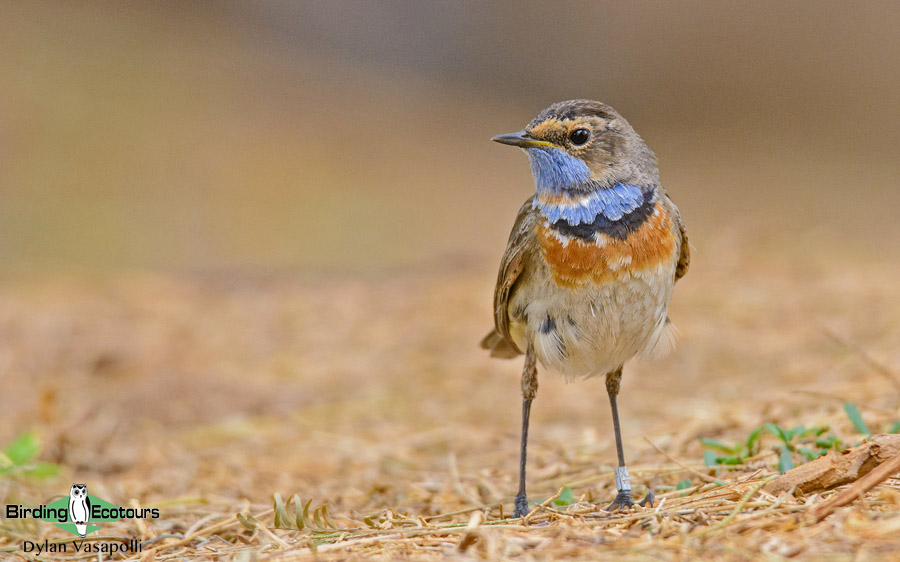
We will also pay a visit to two of the fjord’s sensational seabird colonies. The first is close to the stunning coastal village of Ekkeroy. The cliffs to the southeast of the village are home to tens of thousands of pairs of Black-legged Kittiwake, and the sight, sound, and smell of this is something to behold. Also occasionally breeding on the cliffs are Black Guillemot, Common Murre (Gulliemot), and Razorbill.
The relentless noise from the colony attracts birds of prey and corvids to the area and it is not uncommon to see hunting in action here. We may witness the giant White-tailed Eagle grabbing adult Black-legged Kittiwakes from the cliffs while Gyrfalcon are often seen overhead on the lookout for unsuspecting birds below. Northern Raven and Hooded Crow also take advantage of this colony by stealing chicks and eggs from the nests and we could witness a Peregrine Falcon swooping through large flocks of shorebirds (waders) on the rocks below too!
The Ekkeroy Peninsula itself is an excellent spot to see Red-throated Pipit and Horned (Shore) Lark while the long grass can attract both Rough-legged Buzzard and Short-eared Owl as they hunt for small mammals.
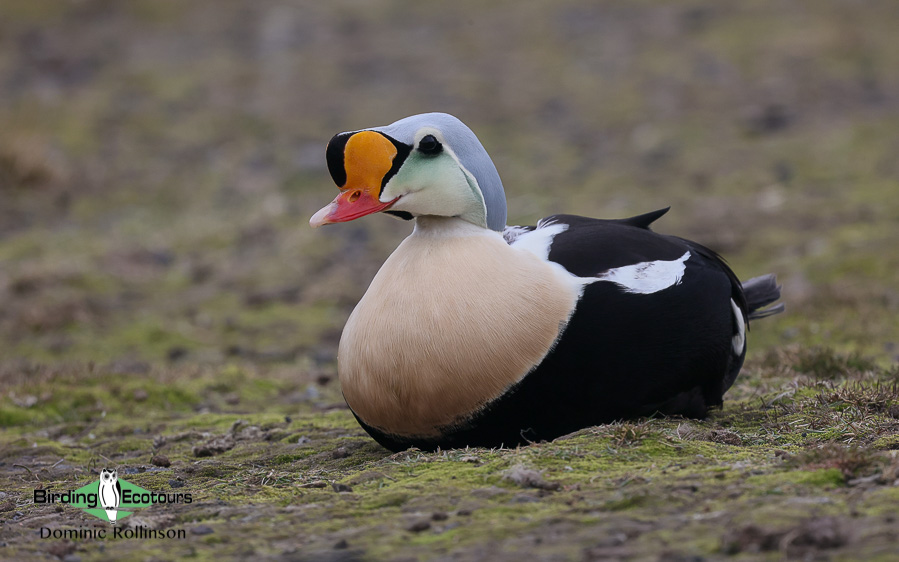
While in the Varangerfjord we will make a boat excursion from the town of Vardø to the islet of Hornøya. The Hornøya Nature Reserve is the easternmost of the protected bird colonies in Norway, home to about 25,000 pairs of Black-legged Kittiwake and 150 pairs of European Shag. Northern alcids breeding here include Thick-billed Murre (Brünnich’s Guillemot), Common Murre (Guillemot), Black Guillemot, Razorbill, and several thousand pairs of Atlantic Puffin.
There are wonderful opportunities here for photographing birds and there will be a nice walk all the way up to the top of the island, where there is a lighthouse. From here we will get excellent views over the Arctic Ocean. The Arctic waters are also home to Grey Seal, Harbor Seal, and occasionally Bearded Seal, which we may see from the boat on the trip to or from the island. Cetaceans can be seen here too including Killer Whale (Orca), Humpback Whale, Harbor Porpoise, Beluga Whale, and several other species.
We will also make an excursion to Hamningberg – the very end of Europe, connected by road from Vardø. The road to Hamningberg is something special. The expression “the end of the world” comes to mind when you travel here. The landscape is wild, and almost a moonscape at times, then round the next bend you could mistake the beaches for those in Spain!
We take several short walks to the tundra and to the bogs here. The latter especially should be teeming with birdlife, in particular breeding Red-throated Loon (Diver) and arctic shorebirds. We will do some sea-watching from Hamningberg, hoping to see Yellow-billed Loon (White-billed Diver), Northern Gannet, Northern Fulmar, Long-tailed Jaeger (Skua), Parasitic Jaeger (Arctic Skua), or even Beluga Whale.
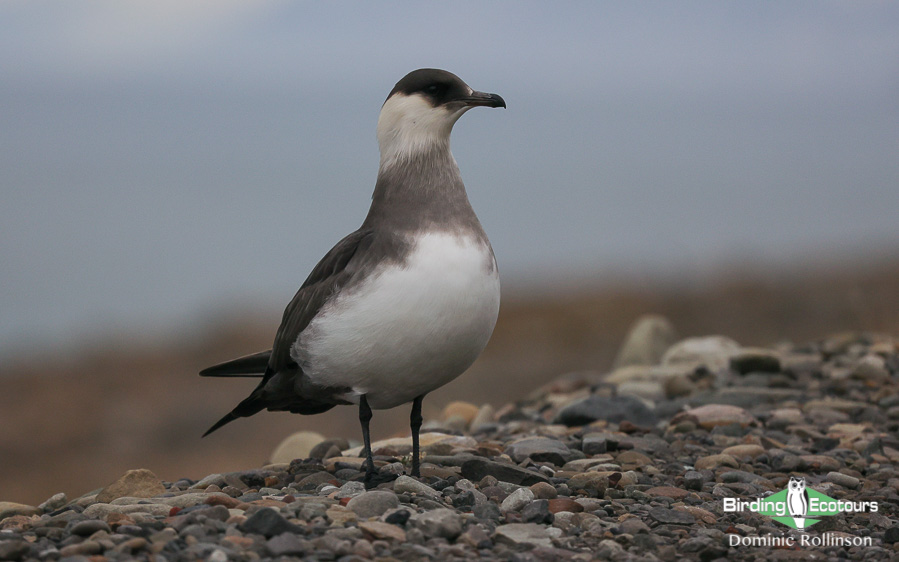
A small river on the way to the village is surrounded by lots of scrub habitat which often holds Bluethroat, Red-throated Pipit, European Rock Pipit, Willow Warbler, Ring Ouzel, Northern Wheatear, Fieldfare, Redwing, Arctic Redpoll, and Twite. This area can also be good for rarer migrants to the region, such as Tawny Pipit and Eurasian Tree Sparrow.
Overnight (two nights): Hotel Vardø, Vardø, Norway
Day 11. Transfer Kirkenes and departure
Today will mostly be a travel day as we make the drive south from Vardø in Norway back to Finland, and the town of Ivalo. We will stop along the route, as we have done in previous days, to look for any of the area’s missing key species. After our bird-filled days in the Arctic weather, we will retreat to our comfortable hotel in Ivalo.
Overnight: Hotel Ivalo, Ivalo, Finland
Day 12. Departure from Ivalo
Time permitting, we may bird in the morning before heading to Ivalo Airport for your flight home, or further connections.
Overnight: Not included
Please note that the itinerary cannot be guaranteed as it is only a rough guide and can be changed (usually slightly) due to factors such as availability of accommodation, updated information on the state of accommodation, roads, or birding sites, the discretion of the guides and other factors. In addition, we sometimes must use a different international guide from the one advertised due to tour scheduling.
Useful information
During this tour, your guide will be driving you in a comfortable vehicle. The tour does require some walking and hiking to see certain species of birds and there are opportunities for longer hikes if you wish. Some of these walks and hikes will be on rough, steep terrain so please make sure you are of a good level of fitness for this tour.
Due to the costs involved with visiting Scandinavia we run this tour with a slightly larger group than we would to other destinations so that we can spread the cost and keep costs down for everyone involved. This decision is also based on the habitats we will be birding in on the tour which allow for larger groups, without reducing the experience of the tour.
The weather in the area can also be highly variable with day temperatures often ranging from 25oC to -8oC in this period depending on the wind strength and direction. Nights are frequently cold and as the sun does not set, many of our excursions will occur later into the evening and early morning.
The forested areas will have noticeable populations of biting insects if the weather is warm so please ensure you bring some form of repellent with you. Despite the northern latitudes, the sun here can be strong in summer, so a hat and sun block are advised.
‘About Finland I can tell you that we had very good opportunities to take photos. We got superb photos of species such as Western Capercaillie, Black Grouse, Hazel Grouse, Great Grey Owl, Ural Owl, Northern Hawk Owl, Pygmy-Owl, Short-eared Owl, Common Goldeneye, Whooper Swan, Common Crane, Parrot Crossbill, Red-flanked Blue-tail, Rustic Bunting, Red-breasted Merganser, Red-necked Grebe, Siberian Jay, Siberian Tit, Willow Tit, Honey-buzzard, Temminck’s Stint, Common Redshank, Baltic and Little Gulls, Eurasian Jackdaw, Hooded Crow, Arctic Tern, Common Cuckoo, Three-toed Woodpecker and Pied Flycatcher.
We also took nice photos of Dotterel, Black-throated Diver, Ruff, Sedge and Icterine Warblers, Red-breasted Flycatcher, Fieldfare, Eurasian Wryneck, Common Redpoll and some other birds.
We missed Terek Sandpiper (we saw it but we can’t take any photos) but another group took very good photos of it before we arrived to the place where the bird was.
To me, it has been an excellent trip to take photographs, plenty of good chances. Undoubtedly it has been the best trip I have made ever in Europe from this point of view.’
Luis and Belen

